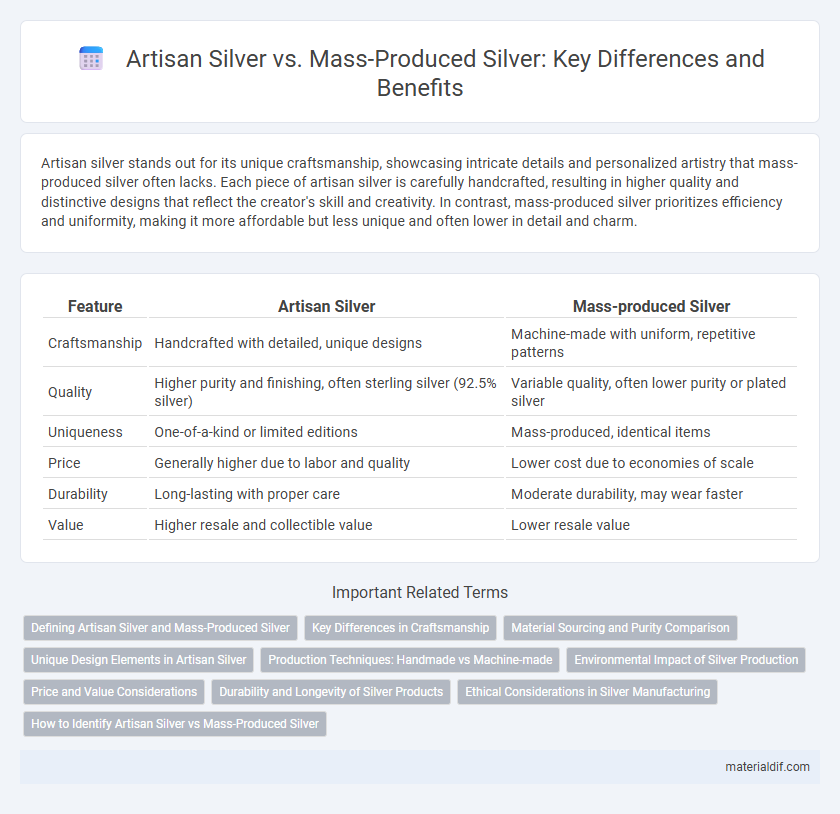Artisan silver stands out for its unique craftsmanship, showcasing intricate details and personalized artistry that mass-produced silver often lacks. Each piece of artisan silver is carefully handcrafted, resulting in higher quality and distinctive designs that reflect the creator's skill and creativity. In contrast, mass-produced silver prioritizes efficiency and uniformity, making it more affordable but less unique and often lower in detail and charm.
Table of Comparison
| Feature | Artisan Silver | Mass-produced Silver |
|---|---|---|
| Craftsmanship | Handcrafted with detailed, unique designs | Machine-made with uniform, repetitive patterns |
| Quality | Higher purity and finishing, often sterling silver (92.5% silver) | Variable quality, often lower purity or plated silver |
| Uniqueness | One-of-a-kind or limited editions | Mass-produced, identical items |
| Price | Generally higher due to labor and quality | Lower cost due to economies of scale |
| Durability | Long-lasting with proper care | Moderate durability, may wear faster |
| Value | Higher resale and collectible value | Lower resale value |
Defining Artisan Silver and Mass-Produced Silver
Artisan silver refers to handcrafted pieces created by skilled silversmiths who emphasize unique designs, intricate detailing, and traditional techniques, resulting in higher quality and artistic value. Mass-produced silver comprises items manufactured on a large scale using machines, prioritizing uniformity and cost-efficiency over individuality and craftsmanship. The defining factors between artisan and mass-produced silver include production methods, design complexity, and the level of manual labor involved.
Key Differences in Craftsmanship
Artisan silver is handcrafted by skilled artisans who meticulously shape, engrave, and polish each piece, resulting in unique, high-quality items with intricate details and a personalized touch. Mass-produced silver relies on automated machinery and molds, producing uniform items with less detailed craftsmanship and minimal variation between pieces. The key difference lies in the level of artistry and attention to detail, where artisan silver emphasizes originality and precision, while mass-produced silver prioritizes efficiency and cost-effectiveness.
Material Sourcing and Purity Comparison
Artisan silver typically involves ethically sourced, higher-purity silver such as 925 sterling or fine silver, ensuring both quality and traceability from responsible mines. Mass-produced silver often utilizes lower-grade alloys or recycled silver with variable purity, sometimes mixed with cheaper metals to reduce costs. This difference in material sourcing directly influences the durability, appearance, and value retention of silver products between the two production methods.
Unique Design Elements in Artisan Silver
Artisan silver showcases unique design elements characterized by hand-crafted details, intricate patterns, and personalized motifs that are rarely found in mass-produced silver. Expert silversmiths employ traditional techniques such as engraving, chasing, and repousse to create one-of-a-kind pieces with distinct artistic value. These bespoke creations reflect cultural heritage and individual craftsmanship, offering a level of uniqueness and authenticity that mass-produced silver lacks.
Production Techniques: Handmade vs Machine-made
Artisan silver is crafted using traditional handmade techniques such as hammering, soldering, and engraving, which result in unique, intricate details and variations in each piece. Mass-produced silver relies on machine-made processes like casting and stamping, enabling high-volume output with consistent shapes and finishes. Handmade production often enhances the artistic value and individuality, while machine-made silver prioritizes efficiency and uniformity.
Environmental Impact of Silver Production
Artisan silver production significantly reduces environmental impact by utilizing traditional methods that minimize energy consumption and limit chemical use, unlike mass-produced silver, which often relies on intensive mining and industrial processes that contribute to habitat destruction and water pollution. Small-scale artisan smelting typically generates less toxic waste and carbon emissions compared to large-scale operations fueled by fossil fuels. Choosing artisan silver supports sustainable mining practices that prioritize ecological balance and promote local economies.
Price and Value Considerations
Artisan silver typically commands higher prices due to handcrafted techniques, unique designs, and superior craftsmanship, offering greater long-term value and exclusivity compared to mass-produced silver. Mass-produced silver benefits from economies of scale, resulting in lower price points but often lacks the intricate detailing and personalized elements found in artisan pieces. Buyers prioritizing investment and originality often favor artisan silver, while those seeking affordability and uniformity lean toward mass-produced options.
Durability and Longevity of Silver Products
Artisan silver products often exhibit superior durability and longevity due to handcrafted techniques and meticulous quality control, resulting in stronger joints and purer silver content. Mass-produced silver items may sacrifice structural integrity and authenticity for cost efficiency, leading to increased susceptibility to wear, tarnish, and damage over time. The artisanal approach typically ensures a higher-grade silver alloy and detailed craftsmanship, enhancing the product's lifespan significantly compared to mass-produced alternatives.
Ethical Considerations in Silver Manufacturing
Artisan silver production emphasizes ethical sourcing by prioritizing small-scale mining operations and fair labor practices, contrasting sharply with mass-produced silver that often involves large-scale mining with environmental degradation and labor exploitation. Ethical considerations focus on minimizing ecological impact, promoting transparency in supply chains, and supporting artisans' livelihoods through sustainable methods. Consumer awareness drives demand for ethically produced silver, encouraging industry shifts toward responsible manufacturing standards.
How to Identify Artisan Silver vs Mass-Produced Silver
Artisan silver pieces often display unique hallmarks, hand-engraved signatures, and slight irregularities in design, distinguishing them from mass-produced silver which typically features uniform markings and machine precision. To identify artisan silver, closely examine the craftsmanship details such as tool marks, variations in weight, and authenticity stamps from recognized silversmiths. Using magnification to inspect the edges and surface can reveal fine traits like hammering or casting inconsistencies absent in factory-made silver items.
Artisan Silver vs Mass-produced Silver Infographic

 materialdif.com
materialdif.com